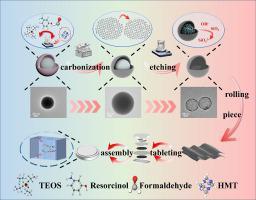Decoupling shell thickness and heteroatom doping in hollow carbon spheres for mechanistic control of charge storage
IF 5.6
3区 材料科学
Q1 ELECTROCHEMISTRY
引用次数: 0
Abstract
Electrochemical supercapacitors must simultaneously deliver high power density, long life, and rising volumetric energy, yet converting surface area rich carbons into compact, fast, and durable electrodes remains nontrivial. Hollow spherical structures have been extensively studied for their application as supercapacitor electrode materials due to their large specific surface area, regular morphology, and numerous modification sites. This work focuses on the precise control of the shell layer thickness of hollow carbon spheres (HCS) while introducing nitrogen atoms via a one-step method to further enhance the material’s volumetric active material density. The resulting HCS-N-1 exhibits an excellent specific capacitance of 381 F g-1 at 1 A g-1 in a three-electrode system, and maintains an astonishing capacitance retention rate of 97.45% after 20,000 cycles at 10 A g-1. The assembled symmetric supercapacitor (SSC) exhibits an preeminent energy density of 32.5 Wh kg-1 at a particularly excellent power density of 2463 W kg-1, with only an 8.41% energy decay after 20,000 charge-discharge cycles. These impressive electrochemical properties highlight the strategic insights provided by this work for the structural design of high-performance hollow spherical carbon materials.

解耦壳厚度和杂原子掺杂在空心碳球中的电荷存储机制控制
电化学超级电容器必须同时提供高功率密度、长寿命和不断增加的体积能量,但将表面积丰富的碳转化为紧凑、快速和耐用的电极仍然不是一件容易的事。空心球形结构由于其大的比表面积、规则的形态和众多的修饰位点,在作为超级电容器电极材料的应用中得到了广泛的研究。本工作的重点是精确控制空心碳球(HCS)的壳层厚度,同时通过一步法引入氮原子,进一步提高材料的体积活性物质密度。所得的HCS-N-1在三电极体系中在1 A g-1下表现出优异的381 F -1比电容,在10 A g-1下循环20,000次后保持97.45%的电容保持率。组装对称超级电容器(SSC)在2463 W kg-1的功率密度下具有32.5 Wh kg-1的卓越能量密度,在20,000次充放电循环后能量衰减仅为8.41%。这些令人印象深刻的电化学性能突出了这项工作为高性能空心球形碳材料的结构设计提供的战略见解。
本文章由计算机程序翻译,如有差异,请以英文原文为准。
求助全文
约1分钟内获得全文
求助全文
来源期刊

Electrochimica Acta
工程技术-电化学
CiteScore
11.30
自引率
6.10%
发文量
1634
审稿时长
41 days
期刊介绍:
Electrochimica Acta is an international journal. It is intended for the publication of both original work and reviews in the field of electrochemistry. Electrochemistry should be interpreted to mean any of the research fields covered by the Divisions of the International Society of Electrochemistry listed below, as well as emerging scientific domains covered by ISE New Topics Committee.
 求助内容:
求助内容: 应助结果提醒方式:
应助结果提醒方式:


